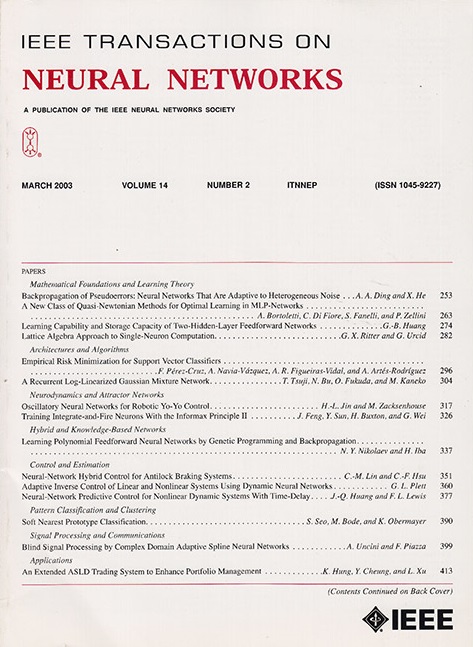TRG-Net:一种可解释和可控的降雨发生器
IF 8.9
1区 计算机科学
Q1 COMPUTER SCIENCE, ARTIFICIAL INTELLIGENCE
IEEE transactions on neural networks and learning systems
Pub Date : 2025-03-27
DOI:10.1109/TNNLS.2025.3565726
引用次数: 0
摘要
探索和建模降雨的产生机制对于增强成对数据以简化降雨图像处理模型的训练至关重要。大多数传统方法通过精心设计构成雨水的基本元素,以人工物理渲染的方式处理这项任务。然而,这类方法过于依赖人的主观性,这限制了它们对真实降雨的适应性。相比之下,最近的深度学习(DL)方法通过从预先收集的雨天图像数据中训练基于神经网络的生成器,取得了巨大的成功。然而,目前的方法通常以“封闭盒”的方式设计生成器,增加了学习难度和数据需求。为了解决这些问题,本研究提出了一种新的基于dl的降雨发生器,它充分考虑了降雨的物理产生机制,并将降雨的基本因素(即形状、方向、长度、宽度和稀疏度)的学习明确地编码到深度网络中。它的意义在于,生成器既像传统的人工策略那样精心设计降雨的基本要素来模拟预期降雨,又像DL方法那样精细地适应复杂多样的实际降雨图像。通过合理地采用滤波参数化技术,所提出的降雨发生器对降雨因子具有很好的可控性,并且可以完全从数据中学习这些因子的分布,而不需要对降雨因子进行标注。我们的非配对生成实验表明,与目前最先进的降雨生成方法相比,所提出的降雨发生器产生的降雨不仅质量更高,而且对脱轨和下游任务更有效。此外,通过分布内和分布外(in-distribution and out- distribution, OOD)的配对数据增强实验,进一步验证了模型生成的样本在分布内脱除和OOD泛化任务中的多样性。本文章由计算机程序翻译,如有差异,请以英文原文为准。
TRG-Net: An Interpretable and Controllable Rain Generator
Exploring and modeling the rain generation mechanism is critical for augmenting paired data to ease the training of rainy image processing models. Most of the conventional methods handle this task in an artificial physical rendering manner, through elaborately designing fundamental elements constituting rains. These kinds of methods, however, are over-dependent on human subjectivity, which limits their adaptability to real rains. In contrast, recent deep learning (DL) methods have achieved great success by training a neural network-based generator from pre-collected rainy image data. However, current methods usually design the generator in a “closed box” manner, increasing the learning difficulty and data requirements. To address these issues, this study proposes a novel DL-based rain generator, which fully takes the physical generation mechanism underlying rains into consideration and well encodes the learning of the fundamental rain factors (i.e., shape, orientation, length, width, and sparsity) explicitly into the deep network. Its significance lies in that the generator not only elaborately designs essential elements of the rain to simulate expected rains, like conventional artificial strategies, but also finely adapts to complicated and diverse practical rainy images, like DL methods. By rationally adopting the filter parameterization technique, the proposed rain generator is finely controllable with respect to rain factors and able to learn the distribution of these factors purely from data without the need for rain factor labels. Our unpaired generation experiments demonstrate that the rain generated by the proposed rain generator is not only of higher quality but also more effective for deraining and downstream tasks compared to current state-of-the-art rain generation methods. Besides, the paired data augmentation experiments, including both in-distribution and out-of-distribution (OOD), further validate the diversity of samples generated by our model for in-distribution deraining and OOD generalization tasks.
求助全文
通过发布文献求助,成功后即可免费获取论文全文。
去求助
来源期刊

IEEE transactions on neural networks and learning systems
COMPUTER SCIENCE, ARTIFICIAL INTELLIGENCE-COMPUTER SCIENCE, HARDWARE & ARCHITECTURE
CiteScore
23.80
自引率
9.60%
发文量
2102
审稿时长
3-8 weeks
期刊介绍:
The focus of IEEE Transactions on Neural Networks and Learning Systems is to present scholarly articles discussing the theory, design, and applications of neural networks as well as other learning systems. The journal primarily highlights technical and scientific research in this domain.
 求助内容:
求助内容: 应助结果提醒方式:
应助结果提醒方式:


